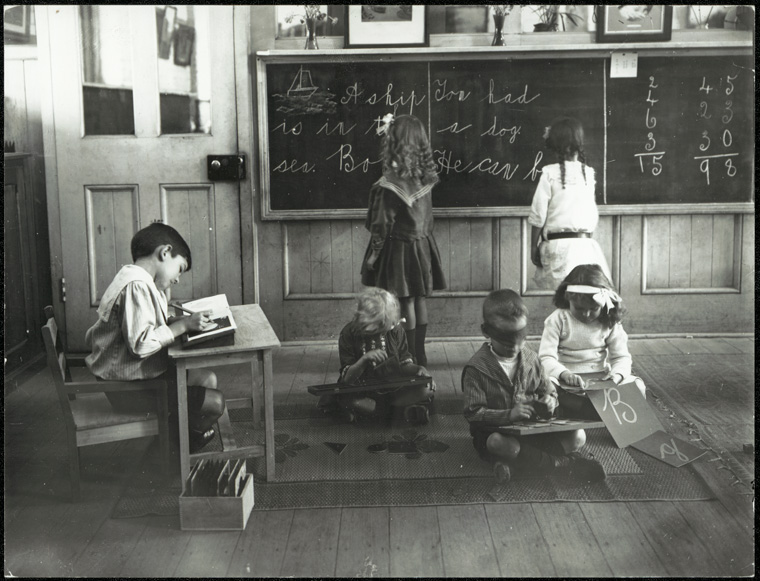The Dictionary of Sydney was archived in 2021.
Newtown

King street Newtown is always more or less busy, but on Saturday night it is seen at its best and brightest. Fancy a double line, more than a mile long, of brilliantly lighted shops; and 'side-walks' so inconveniently crowded, that it is often a matter of some difficulty to push one's way through the throng of people on business and on pleasure bent.That was in 1889, but it equally applies to 2014. This quote opens a little walking tour that the Dictionary of Sydney is invovled with. The Dictionary partnered with the City of Sydney to provide extra content in their new walking tour app: Sydney Culture Walks. There are six history walks - including Newtown - and six public art walks currently in the app. You can choose a curated walk and then see points of interest along the way. Each site has image and text and then has a link to the Dictionary of Sydney, where you can find more images and stories. On the Newtown walk you can discover the history of Newtown Railway Station, the Newtown Bridge and the Hub. There were once produce markets in Newtown, and of course there is the civic precinct with Newtown Town Hall, the courthouse, fire station and school of arts. And did you know, the grand department store Marcus Clark and Co first started in Newtown? It's all there waiting to be discovered. Sydney Culture Walks is a great app. The Dictionary of Sydney is very proud to have contributed to the content in the app and making your discovery of Sydney's history that extra bit special. It is the ideal companion for discovering the city on foot - you can discover hidden laneways and new neighbourhoods while learning about Sydney's fascinating history and the stories behind the city's most loved public artworks. So get out there and explore Sydney's history. Download the Sydney Culture Walk app from Google Play or the Apple Store or visit http://www.sydneyculturewalksapp.com/ --- If you missed Lisa this morning on 2SER breakfast you can catch up with the podcast here. Lisa and Mitch talk about Sydney history every Wednesday morning at 8:20am on 107.3. Tune in!
Soccer in Sydney

The State Theatre

The Sydney Film Festival

The City of Forking Paths

Sydney crime fiction

RESOURCES FOR TEACHERS
EDUCATION
EDUCATION
The Dictionary of Sydney is a rich source of history for students and teachers and we are pleased to extend our resources to include units of study for primary and secondary students. We believe that an understanding of Australian history cultivates a rich foundation for school students to acquire an understanding of global perspectives and to honour our past and present heritage.

SECONDARY
Our secondary programs are based on Dictionary of Sydney articles. These programs include a PDF of the program outlining the activity and in some cases, as indicated, resources that have been developed to support the program. Each program outlines the links to both the Australian Curriculum and the current NSW Syllabus and includes key inquiry questions, an estimation of the time required to complete the activities, and appropriate hyperlinks to the Dictionary of Sydney.
Developed by Prudence MacLeod for the Dictionary of Sydney with support from the Sydney Mechanic School of Arts.
| Depth Study | Resources |
Making A Better World - Movement of Peoples (1750-1901) |
Life on board and Plotting the journey (ACDSEH083)
Lives are changed (ACDSEH084)
Impact (ACDSEH085)Pemulwuy and Bennelong (ACDSEH085)The many hats of early contact (ACDSEH085)
|
Australia and Asia - Making a Nation |
Stolen Generations (ACDSEH020)
19th century Chinese migration (ACDSEH089) |
World War I |
Propaganda, conscription and treatment of Germans (ACDSEH096)
The ANZAC legend is born (ACDSEH097)
The impact of the war on returned soldiers/civilians (ACDSEH110)
|
World War II |
Women's changing place (ACDSEH109)
|
The Globalising World - Migration experiences |
Vietnamese migration (ACDSEH146)
|
| Depth Study | Resources |
Investigating the Ancient Past |
Investigating Australia's Ancient Past (ACDSEH031)
|
PRIMARY
A key component of the general capabilities outlined in the Australian curriculum is promoting critical and creative thinking. Our primary units of study integrate key inquiry questions suggested in the syllabus and include teaching and learning experiences based on CREATE: Appreciation for Learning Theory.
Developed by Christina Aloisio (MEdLead, BTeachLib, DipArts).
| Year Level | Resources |
CREATE |
Critical and Creative Thinking Theory - outline Resource (PDF 278kb) |
Foundation |
What is my history and how do I know? How can stories of the past be told and shared? Resource (PDF 215kb) |
Year 1 |
How can we show that the present is different from or similar to the past? Resource (PDF 213kb) |
Year 2 |
What aspects of the past can you see today? What do they tell us? Resource (PDF 220kb) |
Year 3 |
How has our community changed? What features have been lost and what features have been retained? Resource (PDF 225kb) |
Year 4 |
Why did the Europeans settle in Australia? Resource (PDF 232kb) |
Year 5 |
What were the significant events and who were the significant people that shaped Australia’s colonies? Resource (PDF 225kb) |
Year 6 |
Why and how did Australia become a nation? Resource (PDF 216kb) |
Sydney's old libraries and reading rooms

Katoomba and coal


